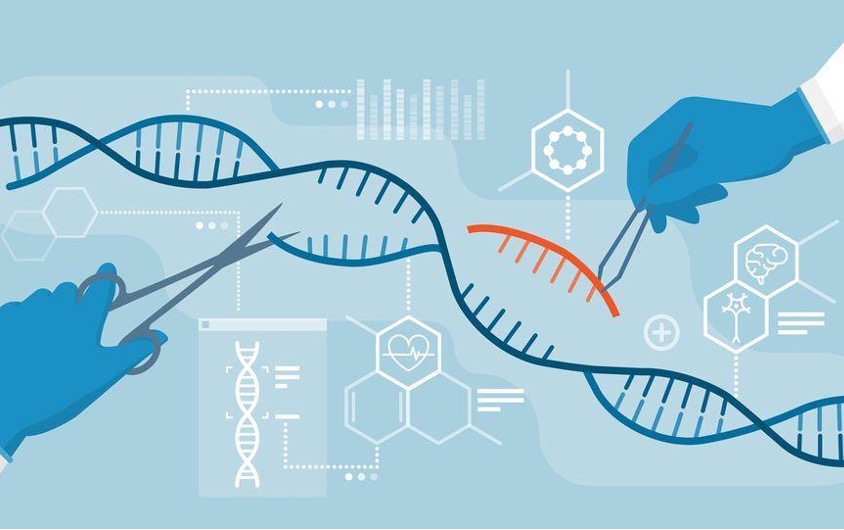
Source: iStock
At just 3 months old, Victoria Gray was diagnosed with sickle cell anemia. Her deformed red blood cells led to excruciating pain episodes as she struggled to care for her four children. After a successful clinical trial, Gray became the first person in the United States to undergo treatment for a genetic disease with CRISPR. In March 2023, she visited London to discuss her CRISPR treatment experience and expressed her gratitude for the “miracles [that] still happen”1. But is genetic engineering truly a miracle?
Genetic engineering lies at the intersection of molecular biology and genetics. Invented by Jennifer Doudna and Emmanuelle Charpentier in 2012, CRISPR gene editing technology has enabled the selective modification of DNA in living organisms2. The repetitive DNA sequences that give CRISPR its name (CRISPR: clustered regularly interspaced short palindromic repeats) were originally observed in bacteria as part of a defense system, much like our own adaptive immune system. The repeats derive from earlier viral infections, when the DNA from these viral invaders was stored in the bacterial genome. In addition to the CRISPR repeats, the system also includes Cas9 nuclease enzymes that are programmed to attach to and cut matching DNA sequences. When another viral particle enters the cell with DNA that matches the CRISPR repeats, the Cas9 enzyme, with the help of a structure called a guide RNA, tracks down the viral DNA and clips it up. These essential features – the tracking down of desired sequences, the selective cutting of DNA – have been repurposed for gene editing.
CRISPR gene editing offers a plethora of possible options, from correcting hereditary disorders to possibly enhancing physical attributes3. Jennifer Doudna, a CRISPR pioneer at University of California Berkeley, predicts that “within 30 years, it will be possible to make essentially any kind of change to any kind of genome” 4. As genetic engineering continues to advance, we, as a society, must determine our bioethical boundaries for implementing this technology medically and cosmetically.
Assuming that measures are taken to protect patient privacy, ensure equitable access, and provide informed consent, genetic engineering efforts based on accredited research are valuable to slowly integrate into the United States healthcare system. These efforts have the potential to treat genetic disorders and improve an individual’s quality of life. But if used recklessly, to enhance a child’s traits for example, these efforts could lead to harmful societal inequities.
Genetic engineering can be classified into somatic and germline gene editing. In somatic gene editing, the DNA of nonreproductive cells is edited to treat diseases caused by genetic mutations with consequences limited to affecting the edited person5. In contrast, germline editing alters the human embryo or reproductive cells from prospective parents, enabling the creation of ‘designer babies’ 6. In the coming generations, future parents might be able to handpick traits from a menu for their children, raising social equity concerns. Time Magazine author Nancy Gibbs contemplates how “we will look at those who are not enhanced” and the possible forms of discrimination such as eugenics that might re-emerge 7 .
According to one recent estimate, somatic gene editing could help preserve the health of an estimated one in 5 people possessing genetic mutations that are known to be risk factors for disease8. However, CRISPR is known to fail in some cases, not introducing the proper genetic change and/or causing ‘off-target’ mutations in undesired parts of the genome9. Furthermore, in a recent study done by the Boston Children’s Department of Pathology, CRISPR seemed to exacerbate the activity of ‘jumping genes’ that replicate themselves and move along the genome. These jumping genes have been linked to cancer10. Although CRISPR is constantly improving in precision and efficiency, both parents and patients should be aware of the unpredictable risks that genetic engineering can pose long-term before lawfully consenting to a procedure.
In addition to these concerns about genetic engineering, people also hesitate to consent to genome sequencing (just sequencing, not editing their DNA), fearful that genomic testing results can increase their medical insurance rates and be released to their employer. To address this concern, congress has passed the 2008 Act of Genetic Information Nondiscrimination Act, preventing insurance providers from accessing genetic information11. While genetic data is essential to furthering research, we must maintain a balance between maintaining one’s privacy and forwarding genetic research.
Before implementing genetic engineering in the clinic, we must continue conducting methodically sound and inclusive research by increasing representation of minority groups in CRISPR research. With increased partnership between researchers, institutional review boards (IRBs), who are responsible for managing clinical trials affiliated with hospitals and research institutions, and patient advocacy groups, trust among disenfranchised communities can be increased and safe minority participation in new CRISPR trials can be promoted 12.
Although genetic engineering is expensive, Gregory Stock, the former Director of the Medicine, Technology, and Society program at the UCLA School of Medicine, shares that “all of these technologies tend to be available initially to the more affluent and motivated”, yet over time become more affordable. Stock references how prices of IVF have dropped to “within the means of a vast number of families in this country.” Like IVF, genetic engineering can become more affordable and widely tested for Americans of all socioeconomic levels over time13.
To realize the great promise of genetic editing – exemplified by the successful treatment of Victoria Gray – all of these issues will need to be addressed. This will require the unified effort of geneticists, clinicians, policymakers, public health organizations, and many others. Clear communication and open conversations about scientific research findings and clinical trial results will help ensure the bright future of gene therapy.
References
- Stein, Rob. (2023). “Sickle Cell Patient’s Success with Gene Editing Raises Hopes and Questions.” NPR. NPR. www.npr.org/sections/health-shots/2023/03/16/1163104822/crispr-gene-editing-sickle-cell-success-cost-ethics.
- MD Anderson Cancer Center, and Julie Nagy. (2022). “What Is CRISPR?” MD Anderson Cancer Center, MD Anderson Cancer Center. www.mdanderson.org/cancerwise/what-is-crispr.h00-159542901.html.
- Iltis, Ana S., et al. (2021). “Public and Stakeholder Engagement in Developing Human Heritable Genome Editing Policies: What Does It Mean and What Should It Mean?” Frontiers, Frontiers. https://www.frontiersin.org/articles/10.3389/fpos.2021.730869/full#B66.
- Bleicher, Ariel. (2023). “Tech Will Soon Give Us Precise Control over Our Brains and Genes.” Technology Will Soon Give Us Precise Control Over Our Brains and Genes | UCSF Magazine. https://magazine.ucsf.edu/technology-will-soon-give-us-precise-control-over-our-brains-and-genes
- Benson, Alvin K., PhD, and Victoria M. A. Breting-Garcia. (2023). “Historical Development of Genetic Engineering.” Salem Press Encyclopedia of Health. EBSCOhost. search.ebscohost.com/login.aspx?direct=true&AuthType=shib&db=ers&AN=94416523&site=eds-live&scope=site.
- Bergman, Mary Todd. (2022). “Harvard Researchers Share Views on Future, Ethics of Gene Editing.” Harvard Gazette. Harvard Gazette. https://news.harvard.edu/gazette/story/2019/01/perspectives-on-gene-editing/. (Website ; Cannon 2019)
- Gibbs, Nancy, et al. (1999). “If We Have It, Do We Use It? (Cover Story).” TIME Magazine. vol. 154, no. 11, p. 59. EBSCOhost. search.ebscohost.com/login.aspx?direct=true&AuthType=shib&db=aph&AN=2226318&site=eds-live&scope=site.
- Cross, Ryan“One in Five ‘Healthy’ Adults May Carry Disease-Related Genetic Mutations.” Science. https://www.science.org/content/article/one-five-healthy-adults-may-carry-disease-related-genetic-mutations.
- Haridy, Rich. (2018). “Why Does CRISPR Randomly Fail 15% of the Time?” Genetic Literacy Project. https://geneticliteracyproject.org/2018/07/23/why-does-crispr-randomly-fail-15-of-the-time/.
- Fliesler, Nancy. (2022). “CRISPR Gene Editing Carries a Potential Risk, Study Finds.” Boston Children’s Answers. answers.childrenshospital.org/crispr-gene-editing/.
- “Timeline of the Genetic Information Nondiscrimination Act (GINA).” (2024). Genome.Gov. www.genome.gov/about-genomics/policy-issues/timeline-genetic-information-nondiscrimination-act-GINA#:~:text=GINA%20prevents%20health%20insurance%20companies,employment%20decisions%20based%20on%20their.
- Hildebrandt, Clara C., and Jonathan M. Marron. (2018). “Justice in CRISPR/cas9 Research and Clinical Applications.” Journal of Ethics | American Medical Association. American Medical Association. https://journalofethics.ama-assn.org/article/justice-crisprcas9-research-and-clinical-applications/2018-09.
- Jonietz, Erika. (2003). “Choosing Our Children’s Genetic Futures.” Technology Review. vol. 106. no. 1, p. 78. EBSCOhost. search.ebscohost.com/login.aspx?direct=true&AuthType=shib&db=b6h&AN=9016532&site=eds-live&scope=site.
Related Posts
Dancing Neurons & Their Exciting Impacts
Figure 1: A network of neurons in the brain Source: Elizabeth...
Read MoreConcierge Medicine Could Reduce Senior Health Inequities in Illinois
This publication is in proud partnership with Project UNITY’s Catalyst Academy 2023...
Read MoreA Novel Mental Health Literacy Education Program for Pre-Teens
Figure: A typical elementary school classroom in Japan (Cassidy, 2005). Source:...
Read MoreThe Environmental Consequences of Civil Wars
Figure 1: This is the flag of Angola, the model...
Read MoreRisk of Death Among Recently Released Inmates
Figure 1: While healthcare inequity is certainly an issue while...
Read MoreAre We Addicted to Social Media?
Cover Image: In the current age, social media has become...
Read MoreSarah Narula






